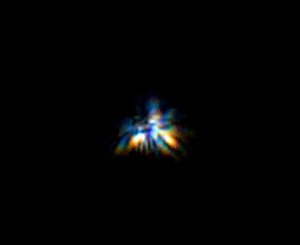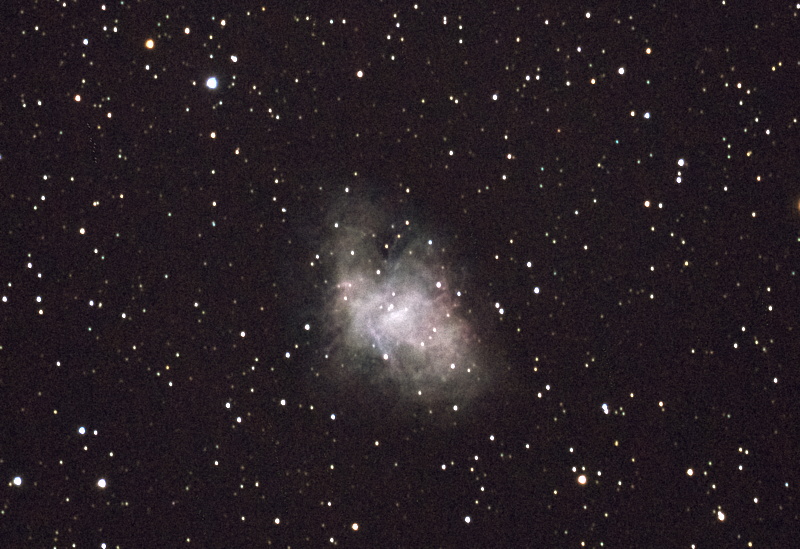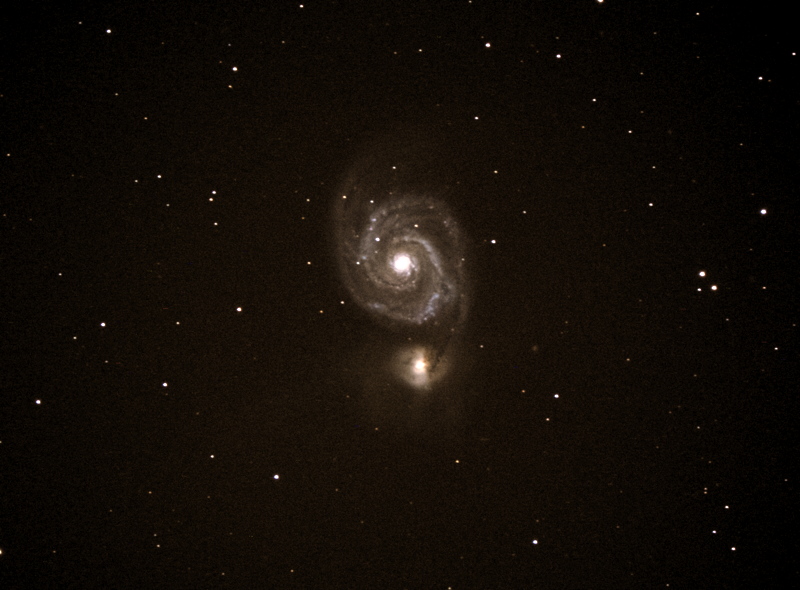
M1 Crab Nebula, NGC4236 Galaxy, M51 Whirlpool Galaxy
Posted: 23 March 2014
|
Opened: Saturday, 22 March 2014, 1828 MST Temperature: 78°F |
Session: 666 Conditions: Clear; occasional breezes |
1836 MST: slewed to Sirius and began observing it to see if I could detect Sirius B (the "Pup Star") using 222X. The bright sky would reduce the glare from Sirius A. 1840 MST: sunset. Used the Bahtinov Mask to ensure a precise visual focus. However, seeing was not very good. At 1851 MST, saw that the neighbor to the north had turned on his bright, horizontal, unshielded, floodlights, and it wasn't even dark yet. I took this afocal 222X handheld photo of Sirius with the D7000 DSLR showing the effects of the lousy seeing, f/5.3, 1/250sec, ISO 400, 62mm:

1859 MST: neighbor turned off the floodlights. Thanks neighbor.
1910 MST: seeing better now. Also, fainter stars were now visible in the eyepiece field-of-view. By 1921 MST, the glare from Sirius was too much and so I ended this attempt to see Sirius B. Slewed to M42 (Great Nebula in Orion) and did some viewing at 83X, still 39 minutes before the end of astronomical twilight. Neighbor to the northeast had now turned on his bright, horizontal, unshielded, floodlight.
1932 MST: began preparing the D7000 DSLR for DSO imaging. 1936 MST: took a quick look at M1 (Crab Nebula), 83X, which would be my first DSO imaging target of the night. Then slewed to Aldebaran, my focus star. Mounted the D7000 at prime focus of the 8" LX200-ACF using a 1.25" visual back.
1944 MST: Zodiacal Light now visible. By 1950 MST, the Zodiacal Light had become surprisingly bright.
Did the focus test imaging using the Bahtinov Mask, then slewed to M1, which was visible in the camera viewfinder. Beginning at 2000 MST, did 15 unguided images of M1, 1 minute duration each, ISO 6400. During post-processing only nine images were untrailed allowing stacking with Lynkeos for an effective exposure time of 9 minutes, with this result:

2030 MST: slewed to NGC4236 (galaxy). Northeast neighbor's floodlight was now off. Thanks neighbor. Added the focal reducer and slewed to Capella for a focus test image using the Bahtinov Mask. Then did 6 unguided images of NGC4236, 2 minute 30 second duration each, ISO 6400. Five images were stacked using Lynkeos for this effective exposure of 12 minutes 30 seconds:

Next, slewed to M51 (Whirlpool Galaxy). It was visible in the camera viewfinder. Did 6 unguided images of M51, 2 minute 30 second duration each, ISO 6400. Five images stacked in Lynkeos (12 minutes 30 seconds effective exposure):

2129 MST: completed DSO imaging. Removed the camera from the telescope but left the focal reducer attached. Viewed M51 using the 24mm UWA eyepiece + focal reducer. Good view of the galaxy. Then viewed M82 galaxy; supernova SN2014j was not visible. I then viewed some of the objects in the AutoStar "Tonight's Best" Guided Tour. I skipped stars, open clusters, and planets. Viewed M42, M104 (Sombrero Galaxy), M68 (globular cluster), and NGC3115 (Spindle Galaxy). Removed the focal reducer and viewed M104, 83X.
2202 MST: viewed Jupiter, 83X. Three moons were visible. Using 222X had a nice view of the planet. At 444X, the view of the planet was fairly good, and disks of the three visible moons were easily seen.
Lastly, viewed Mars, 222X. The planet was too low in the sky for good seeing, but both polar caps were visible as was Syrtis Major.
|
Closed: Saturday, 22 March 2014, 2225 MST Temperature: 56°F |
|
On my previous report I mentioned a problem had developed with the wireless receiver of my Vello ShutterBoss Timer Remote. After almost two years of flawless operation, it would not trip the camera shutter. I did some troubleshooting and discovered:
1. The cable doesn’t seem to seat properly in the jack on the receiver. It seems looser than it used to be.
2. When I press the shutter button on the transmitter the camera will auto-focus via the receiver but the shutter is not tripped.
3. Wired mode with the cable connected directly to the transmitter works OK and trips the shutter.
4. Battery levels on the camera, the transmitter, and the receiver were good.
Since the wired mode works properly, I suspect the receiver has failed.
On Thursday, 20 March, I emailed Vello Technical Support and am waiting for a response. While waiting for a replacement receiver I will use the remote in "wired" mode.
Comments are welcome using Email. If you are on Twitter you can use the button below to tweet this report to your followers. Thanks.
Cassiopeia Observatory Home Page